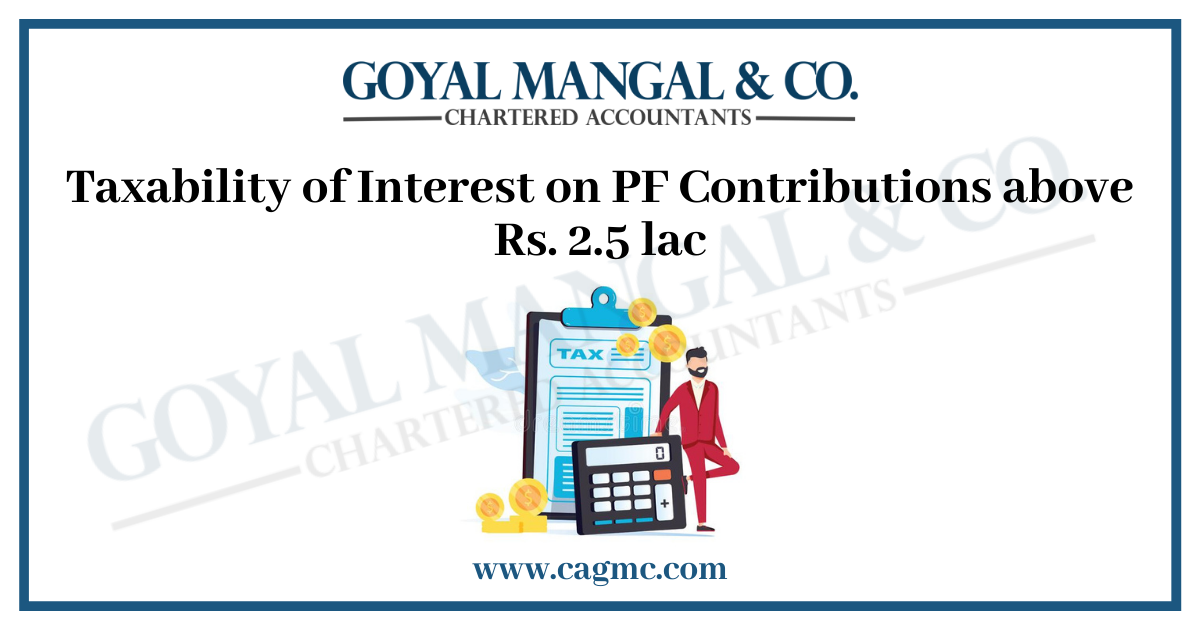
Provident Fund revenue has been tax-free for many years. As with old provisions, at least 12% of salary should have been paid to the employer and employee in the Provident Fund. More than 12% of an employer’s salary was tax-deductible.
To bring more benefits to higher-income earners under tax revenues, the Union Budget 2020 has introduced an amendment. Accordingly, the employer’s contribution to the Provident Fund, National Pension Scheme (NPS), and Superannuation Fund above Rs.7.5 lakh will be taxable as an asset required by the employee. This article focuses on the Taxability of interest on PF contributions above Rs. 2.5 lac.
|
Table of Contents- |
Announcement on the taxability of interest on PF contributions above Rs. 2.5 lac
In the Budget 2021, it was declared that interest amount under Employees’ Provident Fund (EPF) and Voluntary Provident Fund (VPF) contributions will be taxed if exceeding Rs 2.5 lakh per financial year. The Central Board of Direct Taxes (CBDT) introduced laws relating to the taxing of excessive EPF. As per the notice, for calculating taxable interest, separate accounts within the provident fund account will be kept during or from the financial year 2021-22. People with contributions from the Employees’ Provident Fund and the Voluntary Provident Fund (VPF) above Rs 2.5 lakh per financial year will now have two separate PF accounts.
The Rs 2.5 lakh limit is for non-government employees. In the case of public servants, the applicable limit is Rs 5 lakh, that is, interest will be taxed at the hands of the employee if contributions to EPF and VPF exceed Rs 5 lakh to FY.
Aim for taxability of interest on PF contributions above Rs. 2.5 lac
The move is aimed at taxing high-income investors in the Employees Provident Fund. At least 12% of the employee’s basic salary and working hours are mandatory as a provident fund, while the employer contributes another 12%. If the earning is more than Rs 20.83 lakh a year, it will attract their interest in contributing a taxable EPF.
The Union Budget 2021 introduced tax on accrued interest on the Employees ’Provident Fund (EPF) account for donations over Rs.2.5 lakh. Here again, the government aimed to fix tax exemptions for high-income earners by setting limits.
To clarify the amendment presented in the 2021 Budget, CBT has issued a notice indicating the calculation of taxable income related to a Provident Fund or Recognized Provident Fund contribution. As per the notice, this amendment to the income tax rules will come into effect from 1 April 2022.
Rules for taxability of interest on PF contributions
The two sections i.e. Sections 10 (11) and 10 (12) of the Income Tax Act, 1962 provide for the exclusion of a statutory PF and a provident fund recognized respectively. Until 31 March 2021, interest deposited annually in the Employee provident fund (EPF) account was tax-free. Deposits in EPF were subject to the Exempt, Exempt, Exempt (EEE) tax category. Thus, the employee was not liable to pay taxes on all three levels – investment, pay, and withdrawal.
- Rule 9D recently clarified that separate accounts within the PF Accounts shall be kept separating the taxable and non-taxable contributions to the PF and interest thereto.
- In terms of Rule 9D, for the calculation of taxable interest, the following separate accounts in the provident fund account shall be retained in the previous year 2021-2022 and for all subsequent years.
Non-taxable contribution
A tax-free contribution account will be the sum of the following:
- The closing account balance from 31 March 2021 which opens the balance from 01 Apr 2021
- Interest arose in paragraphs 4 (a) and 4 (b)
- Any donation made by a person on account for the previous year 2021-2022 and subsequent years up to the limit of the tax-free contribution.
Taxable contributions
It will be an aggregate of the following:-
- Contribution from the previous year to the account for the previous year 2021-2022 and for the following years, which is more than the limit
- Interest earned on a contribution made in excess.
Key features of this amendment
- This interest rate will apply only to contributions made on or after April 1, 2021.
- The principal employee contribution, employer contribution, all interest earned on employer’s contribution, and interest earned by the employee up to 31 March 2021 are tax-free.
- Interest earned overpassing contributions will be taxable only in those situations where the PF annual employee contribution surpasses Rs. 2, 50,000, or Rs 5, 00,000.
- Contribution to PPF is already limited to Rs. 1.5 lakhs p.a. at the moment, so this amendment will not affect the provision of PPF.
Final words
As per the notice, additional contribution interest income (over Rs 2.5 lakh for private and Rs 5 lakh for public servants) per annum will be taxed annually. This means that if your annual contribution to PF on FY22 is Rs 10 lakh, the interest of Rs 7.5 lakh will be taxed not only on FY22 but for all subsequent years. The new budget included anew change on the taxability of interest on PF contributions above Rs. 2.5 lac. If the PF contribution is the same as in FY23, the tax will be paid at the interest of Rs 15 lakh. Also, if you earn 8.5% interest last year, and if you fall into the highest tax brackets, the following year you will successfully earn about 5.85% of additional income.


